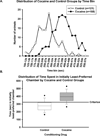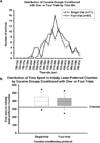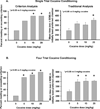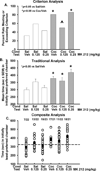Novel approach to data analysis in cocaine-conditioned place preference
- PMID: 19901823
- PMCID: PMC3725613
- DOI: 10.1097/FBP.0b013e328333b266
Novel approach to data analysis in cocaine-conditioned place preference
Abstract
Only a subgroup of human drug users progress from initial drug taking to drug addiction. The learned associations between the effects of the drug and the environment in which it is experienced is an important aspect of the progression to continued drug taking and drug seeking. These associations can be modeled using the conditioned place preference (CPP) paradigm, although no current method of CPP analysis allows for the identification of within-group variability among subjects. In this study, we adapted a 'criterion' method of analysis to separate 'CPP expressing' from 'non-CPP expressing' rats to study more directly within-group variability in the CPP paradigm. Male Sprague-Dawley rats were conditioned with cocaine (5, 10, 20 mg/kg) or saline in an unbiased three-chamber CPP apparatus in either a single-trial or four-trial CPP procedure. A classification and regression tree analysis of time spent in the cocaine-paired chamber established a time of 324 s spent in the cocaine-paired chamber as the criterion for cocaine CPP expression. This criterion effectively discriminated control from cocaine-conditioned rats and was reliable for rats trained in both single trial and four-trial CPP procedures. The criterion method showed an enhanced ability to detect effective doses of cocaine in the single-trial CPP procedure and a blockade of CPP expression by MK 212 (0.125 mg/kg) treatment in a subgroup of rats. These data support the utility of the criterion analysis as an adjunct to traditional methods that compare group averages in CPP.
Figures




References
-
- Adams JU, Careri JM, Efferen TR, Rotrosen J. Differential effects of dopamine antagonists on locomotor activity, conditioned activity and conditioned place preference induced by cocaine in rats. Behav Pharmacol. 2001;12:603–611. - PubMed
-
- Allan AM, Galindo R, Chynoweth J, Engel SR, Savage DD. Conditioned place preference for cocaine is attenuated in mice over-expressing the 5-HT(3) receptor. Psychopharmacology (Berl) 2001;158:18–27. - PubMed
-
- Bardo MT, Bevins RA. Conditioned place preference: what does it add to our preclinical understanding of drug reward? Psychopharmacology (Berl) 2000;153:31–43. - PubMed
-
- Belzung C, Barreau S. Differences in drug-induced place conditioning between BALB/c and C57Bl/6 mice. Pharmacol Biochem Behav. 2000;65:419–423. - PubMed
-
- Bevins RA, Cunningham CL. Place conditioning: a methodological analysis. In: Anderson MJ, editor. Tasks and Techniques: A Sampling of Methodologies for the Investigation of Animal Learning, Behavior, and Cognition. New York: Nova Science Publishers, Inc; 2006. pp. 99–110.
Publication types
MeSH terms
Substances
Grants and funding
LinkOut - more resources
Full Text Sources
Other Literature Sources

